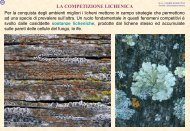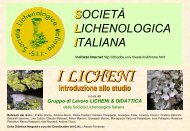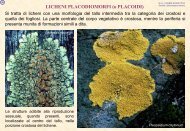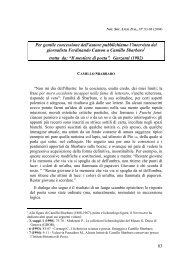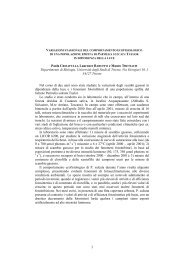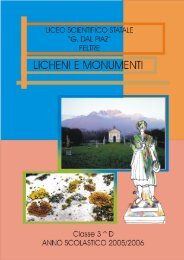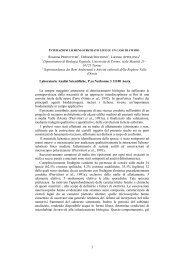KEY to terricolous lichens - italic
KEY to terricolous lichens - italic
KEY to terricolous lichens - italic
You also want an ePaper? Increase the reach of your titles
YUMPU automatically turns print PDFs into web optimized ePapers that Google loves.
19 Thallus K+ red 20<br />
19 Thallus K- 21<br />
20 Thallus P+ red. Primary squamules forming dense mats<br />
Cladonia polycarpoides<br />
Thallus squamulose, grey, K+ red, C-, KC-, P+ red. Primary squamules large, forming<br />
dense mats. Undersurface of squamules white. Pycnidia dark, semi-immersed. Conidia<br />
cylindrical. Pho<strong>to</strong>biont chlorococcoid. - Note: on more or less calcareous mineral soil<br />
in open grasslands and on soil pockets on large isolated boulders, probably somehow<br />
overlooked in Italy and more widespread in the Alps.<br />
20 Thallus P+ orange.<br />
Cladonia symphycarpa<br />
Thallus squamulose, grey, K+ red, C-, KC-, P+ orange. Podetia <strong>to</strong> 1 cm tall, very rare,<br />
with irregular cups. Primary squamules large, <strong>to</strong> 2-3 mm tall, horizontally spreading,<br />
with recurved margins, grey-green above. Undersurface of squamules white.<br />
Ascospores 8 per ascus. Pycnidia dark, semi-immersed. Conidia cylindrical.<br />
Pho<strong>to</strong>biont chlorococcoid. - Note: on calcareous ground in dry grasslands or on the<br />
<strong>to</strong>p of large, exposed calcareous boulders, certainly occurring throughout S Italy.<br />
21 Squamules not white below 22<br />
21 Squamules white below 23<br />
22 Primary squamules 15-40 x 2-10 mm, forming straggling clusters<br />
Cladonia convoluta<br />
Thallus squamulose, greenish grey, K-, C-, KC-, P+ red. Podetia <strong>to</strong> 1 cm tall, very<br />
rare. Primary squamules very large (>10 mm), 15-40 x 2-10 mm, sometimes with<br />
black or white hairs at the margins, forming straggling clusters. Undersurface of<br />
squamules yellowish. Pycnidia dark, semi-immersed. Conidia cylindrical. Pho<strong>to</strong>biont<br />
chlorococcoid. - Note: on mineral soil in dry grasslands, or in intradunal depressions,<br />
also occurring in dry-continental Alpine valleys.<br />
22 Primary squamules 4-15 x 1-3 mm, forming compact mats<br />
Cladonia foliacea<br />
Thallus squamulose, greenish grey, K-, C-, KC-, P+ red. Podetia <strong>to</strong> 1 cm tall, very<br />
rare. Primary squamules very large (>10 mm), 4-15 x 1-3 mm, forming compact mats,<br />
sometimes with black hairs at the margins. Undersurface of squamules yellowish.<br />
Ascospores 8 per ascus. Pycnidia dark, semi-immersed. Conidia cylindrical.<br />
Pho<strong>to</strong>biont chlorococcoid. - Note: an ecological vicariant of C. convoluta on more or<br />
less acid, but often base-rich ground.<br />
23 Thallus greenish grey. Primary squamules thin, irregularly incised and ascending,<br />
often forming low cushions<br />
Cladonia caespiticia<br />
Thallus squamulose, greenish grey, K-, C-, P+ red. Podetia <strong>to</strong> 3 mm tall, decorticate.<br />
Primary squamules medium-sized (1-3mm), <strong>to</strong> 7 mm long, irregularly incised and<br />
ascending, often forming low cushions. Undersurface of squamules white. Medulla<br />
UV -. Pycnidia semi-immersed. Conidia cylindrical. Pho<strong>to</strong>biont chlorococcoid. -<br />
Note: on mineral, generally sandy-clay soil, occasionally on rotting wood and on<br />
bases of ancient trunks, in rather sheltered situations.<br />
23 Thallus brownish-greyish green. Primary squamules 1-2 mm thick, flat, forming a<br />
subrosulate crust<br />
Cladonia pocillum<br />
Thallus squamulose, brownish-greyish green, K-, C-, KC-, P+ red. Primary squamules<br />
medium-sized (1-3mm), 1-2 mm thick, flat, forming a subrosulate crust. Undersurface<br />
of squamules white. Medulla UV -. Ascospores 8 per ascus. Pho<strong>to</strong>biont<br />
chlorococcoid. - Note: on soil and amongst bryophytes in dry, open grasslands, one of<br />
the most common Cladonias of Italy, the distinction <strong>to</strong>wards C. pyxidata is wellworthy<br />
of a DNA study, in my opinion, the two taxa might prove <strong>to</strong> be well-distinct.<br />
24 With isidia. Thallus C+red, KC+ red<br />
21



